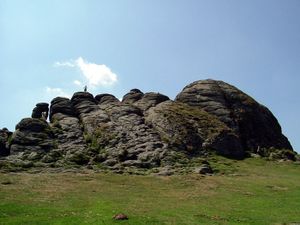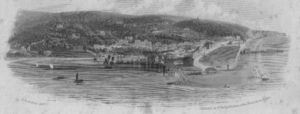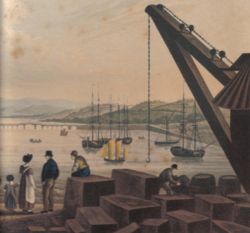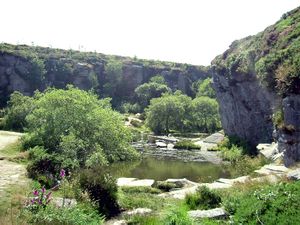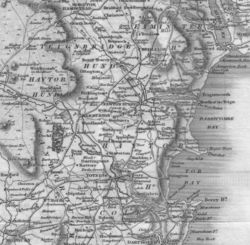Haytor Granite Tramway
The Haytor Granite Tramway was a unique granite-railed tramway on Hay Tor, Dartmoor, Devon. The tramway was built to carry Haytor granite, which was of fine grain and high quality, down from the heights of Dartmoor for the construction of houses, bridges and other structures. In 1850 the quarries employed about 100 men but by 1858 they had closed due to the availability of cheaper Cornish granite (Minchinton 1974).
Contents
Operation and Purpose
Hay Tor] was used for quarrying granite, which was then transported the 10 miles horizontally and 1300 feet vertically by wooden trams with iron wheels pulled by horses or run by gravity to the Stover Canal. The gradients were such that no single part of the line required more horses to be added as 'banking engines'. A siding at Manaton Road may have been used to allow trains to pass. The Stover Canal had been built by James Templer, Esq. in 1770 (Stirling 1830) or January 1790 (Hadfield 1967) for the clay traffic and was extended to Teigngrace by James in 1820 (Griffiths 1965). From here the granite was carried by canal boat to the New Quay at Teignmouth for export by ship, the quay having been built in 1827 for the purpose, making midstream transhipment no longer necessary (Hadfield 1967). In 1829, due to financial difficulties, George Templer sold Stover house, the canal and the tramway to Edward Adolphus Seymour, the eleventh Duke of Somerset. George Templer left Devon, only to return a few years later, building a new mansion at Sandford Orleigh on the outskirts of Newton Abbott. He became the granite company's chief Devonshire agent (Ewans 1966).
Accidents were not uncommon as the only braking was provided by the horses and long wooden poles forced against the wheels. Early accounts refer to the 'rail-road' without always commenting on its 'granite' nature as any form of rail-road was a rarity at the time (Stirling 1830). Ironically iron mines existed nearby at the time. Then short cast iron rails of the time were very prone to breaking and the granite was an ideal substitute (Ewans 1966).
The wooden flat-topped wagons had iron flangeless wheels and ran in trains of usually twelve waggons drawn by around 18 horses in single file, in front for the upward journey and at the rear for the downward (Minchinton 1974). An old sailor called Thomas Taverner wrote a poem which gives us this information:-
|
The vehicles used were probably adapted road wagons and were about 13 ft long, with a wheelbase of 10 ft. The wheels were 2 ft in diameter, 3 in wide on tread and were loose on the axles. The twelve-wheeled reference in the poem above means 'twelve waggons with wheels' (Ewans 1966).
Stover House itself, then the home of the Templer family, had been constructed of Haytor granite in 1781 (Stirling 1830). Granite's popularity as a building material was increasing and the reason for the quarry and tramway's creation was most likely a contract for George Templer to use the stone for London Bridge. Part of the British Museum, the old General Post Office in London and the Waltham Monument in Ludgate Circus were built of Haytor granite in the 19th century. The last use of Haytor quarried granite was the building of the Exeter War Memorial.
The splitting of the granite was done by a method known as 'feather and tare', which had replaced the former 'wedge and groove' method around 1800; this more reliable method being another reason why the use of granite had become practicable. The new method worked by means of a series of holes was made along a potential line of fracture using a tool called a 'jumper'. 'Feathers', were metal prongs with a curved upper end. Two of these were inserted into the holes, the curves in opposite directions at 90 degrees to the line of potential fracture. A wedge shaped metal tare was hammered between the two until the granite fractured.
The granite trade was always somewhat sporadic with fluctuating production and indeed no granite was produced or transported between 1841 and 1851 and the quarries and tramway had closed by 1858. Several thousands of tons of granite had been quarried some years, but competition from Cornish granite quarries with cheaper transport put paid to the business and the tramway fell into neglect, however its robust construction and low recyclable value meant that it was never lifted and much has survived the passage of time.
Route and Construction
The tramway was built in 1820 without an Act of Parliament (Thomas 1966) and opened on 16 September 1820, but the consulting engineer is unknown, although George Templer of Stover House managed the quarries and was no doubt responsible. The description of the official opening shows the extent of the achievement (Thomas 1966) :-
"On Saturday Mr.Templer, of Stover House, gave a grand fete champetre on Haytor Down, on the completion of the granite rail road. The company assembled at its foot on Bovey Heathfield, and in procession passed over it to the rock. A long string of carriages, filled with elegant and beautiful females, multitudes of horsemen, the workmen on foot, the waggons covered with laurels and waving streamers, formed in their windings through the valley, an attractive scene to spectators on the adjacent hill. Old Haytor seemed alive: its sides were lined with groups of persons, and on its top a proud flag fluttered in the wind."
"Among the company were Lord & Lady Clifford of Ugbrooke; Mr. Bastard from Buckland; Sir Thomas Dyke Acland; Sir Henry Carew from Haccombe; Sir Lawrence Palk from Haldon, beside many other county magmnates from other parts. After a speech by Mr. Templer there were high jinks and dances on the turf. 'Never,' writes the ecstatic reporter of an Exeter paper, 'was the Haytor's sod graced with such blooming fair ones, nor did it ever before display so festive a scene."
The construction is unique, the closest possibly being the Weedon stoneway of 1837 which was built as a mail coach route by the Turnpike Commissioners in competition with the London & Birmingham Railway.
The tramway itself was built out of the granite it would carry and ran from the Haytor quarries to Ventiford Quay on the Stover Canal (Minchinton 1974). At first it was about 7 miles long, but was later extended to about 9 miles, or 10 including the various sidings (Hadfield 1967). The hard granite stone was well suited to the purpose as it can withstand high pressures and was laid in lieu of iron rails. The tramway had a mainline running down to the Stover canal and six branches or sidings running from the separate quarries. The sidings were altered several times during the existence of the line and track was often lifted and used elsewhere as circumstances demanded. Various cuttings, embankments and bridges exist along the line.
Owing to the nature of the 'rails' large parts of the old tramway still exist, especially in the area below Haytor itself. Of particular interest are the complex "points" from which trucks were directed down different lines of the tramway, originally with a movable 'iron shoe' portion to direct the trains. Parts of the track are to be found in hedges, walls, bridges and gardens. The granite rails had 'L' shaped grooves with the flanges on the inside and ran a parallel course, whilst some of the points were large blocks of solid granite. The gauge of track was at the flanges 4.25 ft and overall 5.5 ft, with the inside of blocks 3 ft. It was officially set at 4.25 ft but varied a little outwith the points as the gauge was held only by the weight and size of the granite sets. The sets were 15 in wide, the inside kerbs being 2 or 3 in high (Hadfield 1967). The rail set blocks were between 4 and 8 ft long, curves being achieved by laying a series of short 'rails' on the inside of the curves. The iron wheels soon wore the straight granite flanges to shape on the curves.
Carrington in the late 1820s relates how the rail-road can be used as a route, for pedestrians or those on horseback, from Haytor to Teigngrace, making the point that a tramway often differs from a railway by effectively being part of a road and also that the frequency of the granite traffic was usually low and slow moving, so passage along the route by the public would not have been particularly hazardous.
Milestones were erected and three remained in 1975. These were at 3 miles close to the former Bovey Potteries, Milestone 4 in a copse just south of the road from Bovey Tracey to Haytor near Lowerdown Cross and Milestone 6 on the north side of the same road to Haytor, soon after it reaches the open commons at the eastern end of Haytor Down (Fairclough 1975). The miles were measured from Ventiford. Passengers were never carried and the milestones may have been a whim on behalf of George Templer. Granite seems to have been the only traffic carried as the company was reluctant to go to the expense of building high sided waggons or trucks for iron ore transportation.
The building of the Moretonhampstead and South Devon Railway in 1866 meant that the tramway could be shortened and the new interchange sidings were at the 'Bovey Granite Siding', 1 mile south of Bovey Tracey (Hadfield 1967). A mile of the old tramway route had been required for the new line, however the tramway had not been used since 1858. None the less, the land owner, the Duke of Somerset, insisted that a siding and a crane should be built; it was probably never used (Hadfield 1967).
The 1831 map of Devonshire by Fisher, Son & Co. depicts the course of the tramway and erroneously shows it running directly down to the Teign without the Stover canal being in existence. A circa 1865 Devonshire map shows the line as still existing, but the new Moretonhampstead branch cuts it off at Teigngrace as already stated (Kingdom 1974).
The Electric Tramway
In about 1905 there was a scheme to electrify the line and run a frequent tram service, however this failed to mature (Thomas 1966). a small power station was built for it however, using Bovey coal to make gas to drive the generator. It was used by the potteries until falling into ruin (Ewan 1964).
The Templer Way
This is a route which follows as closely as possible the route of the Haytor Granite Tramway and the Stover Canal between Hay Tor and Newton Abbot. It then follows the old exporting route for the granite down to the New Quay in Teignmouth docks. A good place to see the track is where it crosses a minor road which leads to Manaton, just off the Haytor to Bovey Tracey road (Westlake 1973). The upper section has been designated an Ancient Monument (Fairclough 1975).
Once off the moor the place to see the track at its best is a small section of the tramway running through Yarner woods, there is also a well made five mile marker stone. The granite track sections can be followed through the woods before the pathway diverts back onto the main Bovey Tracey road. the tramway cuts across fields down to the road which runs beside the Edgemoor Hotel and a few track sets lie scattered on the lawn of this hotel, but no clear line of the track cannot be distinguished. Chapple Bridge was the only bridge on the tramway, crossing the Bovey leat, until the opening of the second quarry at Holwell Tor. Ventiford Cottages were built to house employees who worked on the tramway and canal, although some lived in a collection of small houses clustered around the inn which lay below Haytor-Rocks (Stirling 1830). Stables were also maintained here for the horses that worked the canal and the railway. Granite Setts can clearly be seen in the construction of bridges on the route of the Templer Waybridge.
Miscellaneous
The Haytor-Rocks and quarries are protected from development and disturbance as a Site of Special Scientific Interest.
In 1936 a Mr. Jeffrys-Jones presented a piece of trackwork to the Science Museum, probably for use in an exhibition which told the story of early trackwork (Ewans 1966).
References
- Carrington, N.T. & others (1820s). The Teignmouth, Dawlish & Torquay Guide: with an account of the surrounding neighnourhood, its scenery, antiquities, etc. Pub. E. Croydon, Teignmouth. P. 31.
- Fairclough, Tony & Shepherd, Eric (1975). Mineral railways of the West Country. Pub. D. Bradford Barton Ltd. ISBN 0-85153-176-8. Pps. 71 & 72.
- Griffiths, G.D. & E.G.C. (1965). History of Teignmouth. Brunswick Press. P. 53.
- Hadfield, Charles (1967). The Canals of South West England. Pub. David & Charles. ISBN 0-7153-4176-6. Pps. 118 - 122.
- Kingdom, Anthony R. ((1974). The Railway of Devon. A Pictorial Survey. Pub. D. Bradford Barton Ltd. P.1.
- Minchinton, Walter (1974). Devon at Work: Past & Present. Pub. David & Charles. ISBN 0-7153-6389-1. P. 89.
- Stirling, Rev. D.M. (1830). A History of Newton-Abbott and Newton-Bushel. P. 161.
- Thomas, David St.John (1966). A Regional History of the Railways of Great Britain. Volume 1. The West Country. Pub. David & Charles. Pps. 57 - 58.
- Westlake, R.J. (1973). Dartmoor. Pub. D. Bradford Barton Ltd. Pps. 84 & 85.
Bibliography
- Ewans, M.C. (1966). The Haytor Granite Tramway and Stover Canal, Pub. David & Charles, Newton Abbot.
- Harris, Helen & Thurlow, George, The Haytor Granite Tramway and Stover Canal, 1994, Peninsula Press, ISBN: 1872640281.
